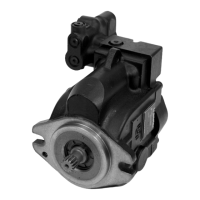General description
Danfoss Series 45 E frame open circuit piston pumps convert input torque into hydraulic power.
Rotational force is transmitted through the input shaft to the cylinder block. The input shaft is supported
by tapered roller bearings at the front and rear of the pump and is splined into the cylinder block . A lip-
seal at the front end of the pump prevents leakage where the shaft exits the pump housing. The spinning
cylinder block contains nine reciprocating pistons. Each piston has a brass slipper connected at one end
by a ball joint. The slippers are held to the swashplate by the spring retainer and block spring. The block
spring also holds the cylinder block to the valve plate. The reciprocating movement of the pistons occurs
as the slippers slide against the inclined swashplate during rotation. Via the valve plate, one half of the
cylinder block is connected to pump inlet and the other half to pump outlet. As each piston cycles in and
out of its bore, fluid is drawn from the inlet and displaced to the outlet thereby imparting power into the
system circuit. A small amount of fluid is allowed to “leak” from the cylinder block / valve plate and
slipper / swashplate interfaces for lubrication and cooling. Case drain ports are provided to return this
fluid to the reservoir.
The volume of fluid displaced into the system circuit is controlled by the angle of the swashplate. The
swashplate is forced into an inclined position (into stroke) by the bias piston and spring. The servo piston
opposes the action of the bias piston and spring forcing the swashplate out of stroke when hydraulic
pressure in the control circuit rises above the spring force.
The pump control, by varying the pressure at the servo piston, controls the displacement of fluid in the
system circuit. Controls designed for Pressure Compensation (PC) or Load Sensing (LS) are available. For a
detailed description of control operation, refer to Control options on page 13.
Pump and control sectional view

